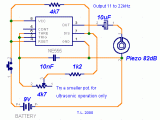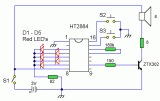Sound and oscillator schematics
 If you are the proud owner of an old oscilloscope tube, you may be interested in using it once more for its original purpose. All you need are the right voltages on the right pins: in practice you may need to peer closely inside to find out which pins on the base correspond to the acceleration and deflection electrodes, in particular if there is no part number to be seen on the tube. The tube we had for experimental purposes was a 7 cm model of unknown provenance....
[read more]
If you are the proud owner of an old oscilloscope tube, you may be interested in using it once more for its original purpose. All you need are the right voltages on the right pins: in practice you may need to peer closely inside to find out which pins on the base correspond to the acceleration and deflection electrodes, in particular if there is no part number to be seen on the tube. The tube we had for experimental purposes was a 7 cm model of unknown provenance....
[read more]
 With the return of the fine weather, you’ll doubtless be enjoying lazing around of an evening on your patio or in your garden, but even if you’re not surrounded by marshes or other shallow water it’s very likely some intruding mosquitoes will come along to spoil this idyllic scene. Although indoors it’s easy to get rid of them these days, indeed even to prevent them coming into the house, the same can’t be said for the great outdoors. We might mention the well-known Chinese coils – the only thing Chinese about them is undoubtedly their name – which very often drive people away as much as mosquitoes, if not more! Moreover they are nasty things to handle....
[read more]
With the return of the fine weather, you’ll doubtless be enjoying lazing around of an evening on your patio or in your garden, but even if you’re not surrounded by marshes or other shallow water it’s very likely some intruding mosquitoes will come along to spoil this idyllic scene. Although indoors it’s easy to get rid of them these days, indeed even to prevent them coming into the house, the same can’t be said for the great outdoors. We might mention the well-known Chinese coils – the only thing Chinese about them is undoubtedly their name – which very often drive people away as much as mosquitoes, if not more! Moreover they are nasty things to handle....
[read more]
 This simple circuit generates narrow pulses at about 700-800Hz frequency. The pulses, containing harmonics up to the MHz region, can be injected into audio or radio-frequency stages of amplifiers, receivers and the like for testing purposes. A high-pitched tone can be heard from the speaker of the device under test when all is working properly. The clip must be connected to the ground of the device under test, touching with the probe the different stages of the circuit, starting from the last stage and going up towards the first. When the tone is no longer heard, the defective stage has been found....
[read more]
This simple circuit generates narrow pulses at about 700-800Hz frequency. The pulses, containing harmonics up to the MHz region, can be injected into audio or radio-frequency stages of amplifiers, receivers and the like for testing purposes. A high-pitched tone can be heard from the speaker of the device under test when all is working properly. The clip must be connected to the ground of the device under test, touching with the probe the different stages of the circuit, starting from the last stage and going up towards the first. When the tone is no longer heard, the defective stage has been found....
[read more]
 Here is the simplest melody generator circuit you can make using an IC.The UM66 series are CMOS IC’s designed for using in calling bell, phone and toys. It has a built in ROM programmed for playing music. The device has very low power consumption.Thanks for the CMOS technology.The melody will be available at pin3 of UM66 and here it is amplified by using Q1 to drive the speaker.Resistor R1 limits the base current of Q1 within the safe values.Capacitor C1 is meant for noise suppression....
[read more]
Here is the simplest melody generator circuit you can make using an IC.The UM66 series are CMOS IC’s designed for using in calling bell, phone and toys. It has a built in ROM programmed for playing music. The device has very low power consumption.Thanks for the CMOS technology.The melody will be available at pin3 of UM66 and here it is amplified by using Q1 to drive the speaker.Resistor R1 limits the base current of Q1 within the safe values.Capacitor C1 is meant for noise suppression....
[read more]
 This oscillator circuit permits crystals to be electronically switched by logic commands. The circuit is best understood by initially ignoring all crystals. Furthermore, assume that all diodes are shorts and their associated 1kO resistors open. The two 1kO resistors at the non-inverting input of IC1 (LT1016) set the output to half the supply, ie, +2.5V. The RC network from the output to pin 3 sets up phase-shifted feedback and the circuit looks like a wide-band unity gain follower at DC. When crystal X1 is inserted (remember, D1 is temporarily shorted) positive feedback occurs and oscillation commences at the crystal’s resonant frequency....
[read more]
This oscillator circuit permits crystals to be electronically switched by logic commands. The circuit is best understood by initially ignoring all crystals. Furthermore, assume that all diodes are shorts and their associated 1kO resistors open. The two 1kO resistors at the non-inverting input of IC1 (LT1016) set the output to half the supply, ie, +2.5V. The RC network from the output to pin 3 sets up phase-shifted feedback and the circuit looks like a wide-band unity gain follower at DC. When crystal X1 is inserted (remember, D1 is temporarily shorted) positive feedback occurs and oscillation commences at the crystal’s resonant frequency....
[read more]
 Do you long for a beach holiday on a tropical island, but you don’t have the necessary wherewithal? We’ve got just the answer: build the i-TRIXX surf simulator, put on your headphones, and dream yourself away from this dreary realm. Let the rhythmic rush of the waves transport you to a sun-drenched beach with gently swaying palm trees, and relax for a while before returning to a chilly confrontation with reality. That’s the ultimate in low-budget travel....
[read more]
Do you long for a beach holiday on a tropical island, but you don’t have the necessary wherewithal? We’ve got just the answer: build the i-TRIXX surf simulator, put on your headphones, and dream yourself away from this dreary realm. Let the rhythmic rush of the waves transport you to a sun-drenched beach with gently swaying palm trees, and relax for a while before returning to a chilly confrontation with reality. That’s the ultimate in low-budget travel....
[read more]
 This two-transistor white noise generator has a surprising feature – about 30dB more noise than the more traditional designs. Q1 and Q2 can be any small-signal transistors with a beta of up to 400. The reverse-biased emitter-base junction of Q1 provides the noise source, which is fed into the base of Q2. Q2 forms a simple amplifier with a gain of 45dB. The improved output level is due mainly to the inclusion of C1, which provides a low-impedance AC source to the noise source while not disturbing the DC bias of Q1....
[read more]
This two-transistor white noise generator has a surprising feature – about 30dB more noise than the more traditional designs. Q1 and Q2 can be any small-signal transistors with a beta of up to 400. The reverse-biased emitter-base junction of Q1 provides the noise source, which is fed into the base of Q2. Q2 forms a simple amplifier with a gain of 45dB. The improved output level is due mainly to the inclusion of C1, which provides a low-impedance AC source to the noise source while not disturbing the DC bias of Q1....
[read more]
 UM66 is a pleasing music generator IC which works on a supply voltage of 3V. the required 3V supply is given through a zener regulator. its out put is taken from the pin no1 and is given to a push pull amplifier to drive the low impedance loud speaker. A class A amplifier before push pull amplifier can be used to decrees the noise and improve out put. UM66 is a 3 pin IC package just looks like a BC 547 transistor....
[read more]
UM66 is a pleasing music generator IC which works on a supply voltage of 3V. the required 3V supply is given through a zener regulator. its out put is taken from the pin no1 and is given to a push pull amplifier to drive the low impedance loud speaker. A class A amplifier before push pull amplifier can be used to decrees the noise and improve out put. UM66 is a 3 pin IC package just looks like a BC 547 transistor....
[read more]
 This multi-tone siren is useful for burglar alarms, reverse horns, etc. It produces five different audio tones and is much more ear-catching than a single-tone siren. The circuit is built around popular CMOS oscillator-cum-divider IC 4060 and small audio amplifier LM386. IC 4060 is used as the mult-itone generator. A 100µH inductor is used at the input of IC 4060. So it oscillates within the range of about 5MHz RF. IC 4060 itself divides RF signals into AF and ultrasonic ranges. Audio signals of different frequencies are available at pins 1, 2, 3, 13 and 15 of IC 4060 (IC1)....
[read more]
This multi-tone siren is useful for burglar alarms, reverse horns, etc. It produces five different audio tones and is much more ear-catching than a single-tone siren. The circuit is built around popular CMOS oscillator-cum-divider IC 4060 and small audio amplifier LM386. IC 4060 is used as the mult-itone generator. A 100µH inductor is used at the input of IC 4060. So it oscillates within the range of about 5MHz RF. IC 4060 itself divides RF signals into AF and ultrasonic ranges. Audio signals of different frequencies are available at pins 1, 2, 3, 13 and 15 of IC 4060 (IC1)....
[read more]
 In Greek mythology, a siren was a demonic being (half bird, half woman). Later on this idea was transformed in art into a mermaid: a combination of a fish and a woman. Mechanical and electromechanical versions were invented even later, and electronic models were developed in the last century. Sirens are characterized by their ability to produce sounds that attract attention. With the exception of the flesh-and-blood models, they are thus used to warn people in a particular area of impending danger. The electronic versions are the most suitable for DIY construction....
[read more]
In Greek mythology, a siren was a demonic being (half bird, half woman). Later on this idea was transformed in art into a mermaid: a combination of a fish and a woman. Mechanical and electromechanical versions were invented even later, and electronic models were developed in the last century. Sirens are characterized by their ability to produce sounds that attract attention. With the exception of the flesh-and-blood models, they are thus used to warn people in a particular area of impending danger. The electronic versions are the most suitable for DIY construction....
[read more]
 This circuit generates a two-tone effect very much alike the cuckoo song. It can be used for door-bells or other purposes thanks to a built-in audio amplifier and loudspeaker. Used as a sound effect generator it can be connected to external amplifiers, tape recorders etc. In this case, the built-in audio amplifier and loudspeaker may be omitted and the output taken across C8 and ground. There are two options: free running, when SW1 is left open, and one-shot, when SW1 is closed. In this case a two-tone cuckoo song will be generated at each P1 pressing....
[read more]
This circuit generates a two-tone effect very much alike the cuckoo song. It can be used for door-bells or other purposes thanks to a built-in audio amplifier and loudspeaker. Used as a sound effect generator it can be connected to external amplifiers, tape recorders etc. In this case, the built-in audio amplifier and loudspeaker may be omitted and the output taken across C8 and ground. There are two options: free running, when SW1 is left open, and one-shot, when SW1 is closed. In this case a two-tone cuckoo song will be generated at each P1 pressing....
[read more]
 This circuit generates a dual-tone bells ringing similar to most door-bell units. It can be used in many applications other than door-bell. In the Notes below several options will be given in order to suit different needs. The circuit as shown in the diagram generates a "Ding-tone" when P1 is pressed and a "Dong-tone" when P1 is released. IC1D is the first-tone frequency generator and IC1F generates the second-tone....
[read more]
This circuit generates a dual-tone bells ringing similar to most door-bell units. It can be used in many applications other than door-bell. In the Notes below several options will be given in order to suit different needs. The circuit as shown in the diagram generates a "Ding-tone" when P1 is pressed and a "Dong-tone" when P1 is released. IC1D is the first-tone frequency generator and IC1F generates the second-tone....
[read more]
 This circuit generates an astonishingly real imitation of the chirping of the cricket. A suitable audio wave form is generated by IC2 and related components, driving the loudspeaker through Q1. To allow a more real-life behavior, the chirp is interrupted in a pseudo-casual way by two timers built around IC1C and IC1D, whose outputs are mixed into IC1B and further time-delayed by IC1A, driving the reset pin of IC2....
[read more]
This circuit generates an astonishingly real imitation of the chirping of the cricket. A suitable audio wave form is generated by IC2 and related components, driving the loudspeaker through Q1. To allow a more real-life behavior, the chirp is interrupted in a pseudo-casual way by two timers built around IC1C and IC1D, whose outputs are mixed into IC1B and further time-delayed by IC1A, driving the reset pin of IC2....
[read more]
 This circuit is intended for children fun, and can be installed on bicycles, battery powered cars and motorcycles, but also on models and various games and toys. With SW1 positioned as shown in the circuit diagram, the typical dual-tone sound of Police or Fire-brigade cars is generated, by the oscillation of IC1A and IC1B gates. With SW1 set to the other position, the old siren sound increasing in frequency and then slowly decreasing is reproduced, by pushing on P1 that starts oscillation in IC1C and IC1D....
[read more]
This circuit is intended for children fun, and can be installed on bicycles, battery powered cars and motorcycles, but also on models and various games and toys. With SW1 positioned as shown in the circuit diagram, the typical dual-tone sound of Police or Fire-brigade cars is generated, by the oscillation of IC1A and IC1B gates. With SW1 set to the other position, the old siren sound increasing in frequency and then slowly decreasing is reproduced, by pushing on P1 that starts oscillation in IC1C and IC1D....
[read more]
 It's well known that many animals are particularly sensitive to high-frequency sounds that humans can't hear. Many commercial pest repellers based on this principle are available, most of them operating in the range of 30 to 50 kHz. My aim was, however, to design a slightly different and somewhat more powerful audio frequency/ultrasonic sound generator that could be used to train dogs. Just imagine the possibilities - you could make your pet think twice before barking again in the middle of the night or even subdue hostile dogs (and I guess burglars would love that!)....
[read more]
It's well known that many animals are particularly sensitive to high-frequency sounds that humans can't hear. Many commercial pest repellers based on this principle are available, most of them operating in the range of 30 to 50 kHz. My aim was, however, to design a slightly different and somewhat more powerful audio frequency/ultrasonic sound generator that could be used to train dogs. Just imagine the possibilities - you could make your pet think twice before barking again in the middle of the night or even subdue hostile dogs (and I guess burglars would love that!)....
[read more]
 Here is a simple triangle/squarewave generator using a common 1458 dual op-amp that can be used from very low frequencies to about 10 Khz. The time interval for one half cycle is about R*C and the outputs will supply about 10 milliamps of current. Triangle amplitude can be altered by adjusting the 47K resistor, and waveform offset can be removed by adding a capacitor in series with the output....
[read more]
Here is a simple triangle/squarewave generator using a common 1458 dual op-amp that can be used from very low frequencies to about 10 Khz. The time interval for one half cycle is about R*C and the outputs will supply about 10 milliamps of current. Triangle amplitude can be altered by adjusting the 47K resistor, and waveform offset can be removed by adding a capacitor in series with the output....
[read more]
 his circuit proved very useful in keeping away from a terrace or a porch some bats and other nocturnal animals. You can use it for similar or different purposes. The lamp illuminates at a 4-5 seconds delay and stays off about one minute and 15 seconds....
[read more]
his circuit proved very useful in keeping away from a terrace or a porch some bats and other nocturnal animals. You can use it for similar or different purposes. The lamp illuminates at a 4-5 seconds delay and stays off about one minute and 15 seconds....
[read more]
 Repell those repugnent insects from your Garden this Summer with this insect repellant circuit. Designed by Graham Maynard the circuitry consists of a phase locked loop (CMOS 4047) wired as a 22KHz oscillator....
[read more]
Repell those repugnent insects from your Garden this Summer with this insect repellant circuit. Designed by Graham Maynard the circuitry consists of a phase locked loop (CMOS 4047) wired as a 22KHz oscillator....
[read more]
 Feeling chirpy? Attract new friends with this modified hartley oscillator. You could also use it as a replacement doorbell....
[read more]
Feeling chirpy? Attract new friends with this modified hartley oscillator. You could also use it as a replacement doorbell....
[read more]
 This circuit generates a good 1KHz sinewave using the inverted Wien bridge configuration....
[read more]
This circuit generates a good 1KHz sinewave using the inverted Wien bridge configuration....
[read more]
 There are a number of npn transistors that will oscillate in the audio range when reverse biased. Minimum supply voltage is 7V for low power transistors such as BC109, BC238 and 2N2222A, it becomes 12V for medium power transistors such as BD139 and is 16V for power transistors as BUX22 and 2N6543. Current drain is 4mA at 9V and frequency of oscillation is 550Hz. The base is normally left open....
[read more]
There are a number of npn transistors that will oscillate in the audio range when reverse biased. Minimum supply voltage is 7V for low power transistors such as BC109, BC238 and 2N2222A, it becomes 12V for medium power transistors such as BD139 and is 16V for power transistors as BUX22 and 2N6543. Current drain is 4mA at 9V and frequency of oscillation is 550Hz. The base is normally left open....
[read more]
 This circuit uses the Holtek HT2884 IC to produce 8 different sound effects....
[read more]
This circuit uses the Holtek HT2884 IC to produce 8 different sound effects....
[read more]
 This circuit uses a UM3561 IC to produce four different sound effects...
[read more]
This circuit uses a UM3561 IC to produce four different sound effects...
[read more]
 Producing low-distortion sine waves, this oscillator operates over the range 16 to 22000 Hz....
[read more]
Producing low-distortion sine waves, this oscillator operates over the range 16 to 22000 Hz....
[read more]
 Built around a single 8038 waveform generator IC, this circuit produces sine, square or triangle waves from 20Hz to 200kHz in four switched ranges....
[read more]
Built around a single 8038 waveform generator IC, this circuit produces sine, square or triangle waves from 20Hz to 200kHz in four switched ranges....
[read more]
 This circuit generates a two-tone effect very much alike the cuckoo sound. It can be used for door-bells or other purposes thanks to a built-in audio amplifier and loudspeaker....
[read more]
This circuit generates a two-tone effect very much alike the cuckoo sound. It can be used for door-bells or other purposes thanks to a built-in audio amplifier and loudspeaker....
[read more]
 This circuit is intended for children fun, and is suitable to be installed on bicycles, battery powered cars and motorcycles, but also in models and other games....
[read more]
This circuit is intended for children fun, and is suitable to be installed on bicycles, battery powered cars and motorcycles, but also in models and other games....
[read more]
 Oscilloscope testing module (huntron circuit)...
[read more]
Oscilloscope testing module (huntron circuit)...
[read more]
 An electronic siren made from discrete components....
[read more]
An electronic siren made from discrete components....
[read more]
 This is a basic 555 squarewave oscillator used to produce a 1 Khz tone from an 8 ohm speaker. In the circuit on the left, the speaker is isolated from the oscillator by the NPN medium power transistor which also provides more current than can be obtained directly from the 555 (limit = 200 mA). A small capacitor is used at the transistor base to slow the switching times which reduces the inductive voltage produced by the speaker....
[read more]
This is a basic 555 squarewave oscillator used to produce a 1 Khz tone from an 8 ohm speaker. In the circuit on the left, the speaker is isolated from the oscillator by the NPN medium power transistor which also provides more current than can be obtained directly from the 555 (limit = 200 mA). A small capacitor is used at the transistor base to slow the switching times which reduces the inductive voltage produced by the speaker....
[read more]